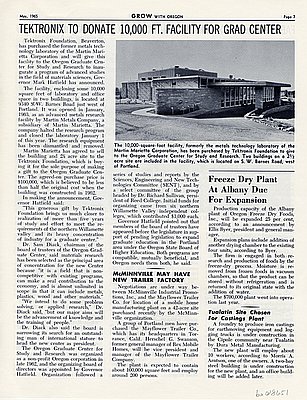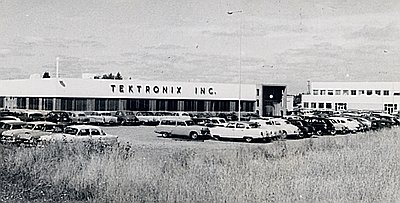This photograph depicts a Tektronix employee studying an invention by the company--a storage oscilloscope. The Washington County high-technology firm's new products recorded faster electronic signals than other oscilloscopes on the market.
Recognition for its oscilloscopes was nothing new to Tektronix. Research institutions and government laboratories had acknowledged Tektronix's superior product by the 1950s. Business soared as the company met the demands of the Korean War and the emerging television and computer industries. The company's success continued into the 1960s and 1970s. The company's 7834 storage oscilloscope gained accolades for Tektronix by winning a prestigious annual industrial research design award that identified it as one of the top one hundred technical innovations of 1977.
Its high profits allowed it to invest resources into research and development projects and educational programs designed to keep employees current on new developments in the field. The number of firms specializing in high technology in the Portland area boomed during the 1960s; whereas there had been five companies in 1950, there were twenty-two by 1962.
Tektronix led the pack in employees and sales figures. By 1980 it was the largest private employer in Oregon and was helping revive the state's economy after the deterioration of the timber industry in the late 1970s. The company's size and influence helped gain notoriety for the Tualatin Valley as a high-technology center, and soon the media began referring to the area as the Silicon Forest, a reference to the Silicon Valley in Santa Clara, California.
The 1980s and 1990s proved to be decades of decline for Tektronix. Increasing worldwide competition from other electronics companies shrank its profits. To cope, Tektronix downsized, cutting half its personnel between 1985 and 1995. The company's influence on regional economies, however, continued. Layoffs released a well-educated workforce into the community. As Tektronix struggled, some engineers grew frustrated that their research did not result in products and left to start their own companies. Tektronix more directly fostered this entrepreneurial spirit with the Tektronix Development Corporation (TDC). As a venture-capital subsidiary, TDC helped new business ventures develop and commercialize products that were sometimes based on technology Tektronix had created. Further, as a part of its downsizing plan, Tektronix divested whole business units; those groups frequently continued as independent Silicon Forest companies. According to Urban Studies Professor Heike Mayer, forty-eight companies spun from Tektronix between 1980 and 2000.
Further reading:
Dodds, Gordon B. and Craig E. Wollner. The Silicon Forest: High Tech in the Portland Area 1945-1986. Portland, Oregon: Oregon Historical Society Press, 1990.
Mayer, Heike. "Planting High-Technology Seeds: Tektronix's Role in the Creation of Portland's Silicon Forest. Oregon Historical Quarterly 106:4 (Winter 2004): 568-593.
Written by Sara Paulson, © Oregon Historical Society, 2007.


